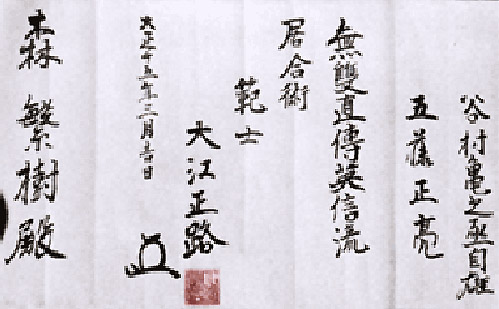 |
THE MOVEMENT OF THE KISSAKI.
The circular line the Kissaki draws is shown on the left.
Example 1 is twisting the body left before drawing the
sword. Neither method is perfect for all practitioners. Individuals should
choose the method to suit their own achievement.
In the case of 2 the shoulders are square and the foot is stamped. Therefore there
is not so much body twist involved. |
MERITS
 As one is facing the opponent
square on, balance can be kept reasonably steady.
As one is facing the opponent
square on, balance can be kept reasonably steady.
 After Nukitsuke, this posture
gives one the capability of comfortably dealing with an ensuing attack
or defence.
After Nukitsuke, this posture
gives one the capability of comfortably dealing with an ensuing attack
or defence.
DEMERITS - 1
 As the upper body takes Hanmi,
the left foot is placed under the hips. This makes it difficult to follow with
immediate action.
As the upper body takes Hanmi,
the left foot is placed under the hips. This makes it difficult to follow with
immediate action.
 The Hanmi posture does not pressurise
the opponent as much as the square shouldered position.
The Hanmi posture does not pressurise
the opponent as much as the square shouldered position.
 An over emphasised twisting movement
confuses the technique with Shimomura Ha.
An over emphasised twisting movement
confuses the technique with Shimomura Ha.
DEMERITS - 2
 Because one can only use the right
hand to draw, the power is not as strong as 2
Because one can only use the right
hand to draw, the power is not as strong as 2
 Because the shoulder is square,
the Kissaki might not reach out enough to cut the opponent.
Because the shoulder is square,
the Kissaki might not reach out enough to cut the opponent.
MERITS - 2
 Nukitsuke action to be sharper
because the hip is pulled and twisted as the Kissaki is dispatched from the
Saya.
Nukitsuke action to be sharper
because the hip is pulled and twisted as the Kissaki is dispatched from the
Saya.
 The Kissaki movement is wider
than in 1 as a diagonal shoulder covers a longer distance.
The Kissaki movement is wider
than in 1 as a diagonal shoulder covers a longer distance.
DYNAMIC APPLICATION.
The techniques are outlined above. The question is how can one increase the
power of the sword? The points to emphasise are; the toes of the left foot ›
left kneecap › hip and Tanden power › force of the arm › right
hand grip › hip twist.
These are all connected to perform a successful Nukitsuke.
 The toes, left kneecap and right
leg support the whole body weight. Balancing of these three points must be studied
carefully to ascertain the correct timing and accord.
The toes, left kneecap and right
leg support the whole body weight. Balancing of these three points must be studied
carefully to ascertain the correct timing and accord.
 The power of the hips and Tanden:
From any movement the root of power lies here. The same applies to Sado (tea),
Buyo (dance), or Shodo (calligraphy). They are the main points of physical movement.
As stated the upper body and hips are supported by the front foot, back knee
and toes The abdominal power should explode with breathing control. The hips
and Tanden are the key points which connect the upper and lower half of the
body in correct posture.
The power of the hips and Tanden:
From any movement the root of power lies here. The same applies to Sado (tea),
Buyo (dance), or Shodo (calligraphy). They are the main points of physical movement.
As stated the upper body and hips are supported by the front foot, back knee
and toes The abdominal power should explode with breathing control. The hips
and Tanden are the key points which connect the upper and lower half of the
body in correct posture.
 The muscle power of the arm, gripping
and Kissaki power. There are four parts of the body which achieve Nukitsuke.
The muscle power of the arm, gripping
and Kissaki power. There are four parts of the body which achieve Nukitsuke.
1. The knees and feet supporting the body weight.
2. The hips and Tanden keeping the body balanced.
3. The upper body holding the correct posture.
4. The arms, hands and sword performing the actual action.
All of these parts must word together in a satisfactory combination to create
a logical and sensible movement. Fundamentals correct posture are the most significant
characteristics of Nukitsuke.
 |
METSUKE
First of all Metsuke is the act of checking and appraising the situation and surroundings.
Then concentrate on the opponent with Enzan-no- Metsuke. (The eyes should
not focus on one specific point). Then dispatch the sword to cut the opponent
before he can begin his action. The teachings about Metsuke by Miyamoto
Musashi in Gorin no Sho are: 1. Kan-no-Metsuke: Feel the opponent with a sixth sense.
2. Ken-no-Metsuke: Look at the opponent with your eyes. Both of these are
wholly correct, but which one to use depends upon the time, place and/or occasion.
One has to feel the opponents existence and look at it, then take action. This
is the standard for most cases and forms. Shinobu in Oku-Iai (Tachiwaza No 5)
is an example of when one should rely on Kan-no-Metsuke as this form is done
in darkness. No matter how one directs these Metsuke one must be mindfully and
mentally alert.
Kongen no Maki |
 |
Page 9 |

